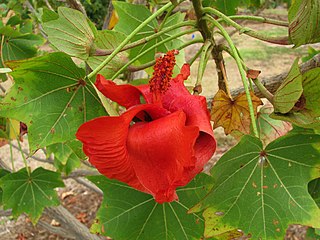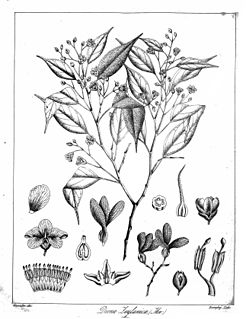
Garcinia is a genus of flowering plants in the family Clusiaceae native to Asia, America, Australia, tropical and southern Africa, and Polynesia. The number of species is disputed; the Kew Gardens recognise up to 400. Commonly, the plants in this genus are called saptrees, mangosteens, garcinias, or monkey fruit.
Ostodes is a genus of plants under the family Euphorbiaceae first described as a genus in 1826. It is native to southern China, the Himalayas, and parts of Southeast Asia.
- Ostodes kuangiiY.T.Chang - Yunnan
- Ostodes paniculataBlume - Hainan, Yunnan, Tibet, Nepal, Sikkim, Bhutan, N Bangladesh, Assam, Thailand, Myanmar, W Malaysia, Borneo, Java, Sumatra

Kokia cookei is a small, deciduous tree commonly known as the kokiʻo, Molokaʻi treecotton, Cooke's kokiʻo, or Molokaʻi kokiʻo.

Crudia zeylanica, sometimes known as Sri Lanka legume, is a species of plant in the family Fabaceae endemic to Sri Lanka. Once thought to be extinct, the plant was rediscovered in 2019.
Garcinia zeylanica is a terrestrial species of flowering plant in the family Clusiaceae. It is found only in Sri Lanka, where it can be seen only in three forest localities.
Microhyla zeylanica. the Sri Lanka rice frog or Sri Lanka narrow-mouth frog, is a species of frog in the family Microhylidae. It is endemic to Sri Lanka. Its natural habitats are subtropical or tropical moist montane forests, subtropical or tropical high-altitude grassland, swamps, freshwater marshes, and intermittent freshwater marshes. It is threatened by habitat loss.
Axinandra zeylanica is a species of plant in the Crypteroniaceae family. It is endemic to Sri Lanka, where locally known as "pol hunna - පොල් හුන්න".
Beauprea congesta is a species of plant in the family Proteaceae. It is endemic to New Caledonia.
Beilschmiedia zeylanica is a species of plant in the family Lauraceae. It is endemic to Sri Lanka.

Campnosperma zeylanicum is a species of plant in the family Anacardiaceae. It is endemic to Sri Lanka.

Helicia is a genus of 110 species of trees and shrubs, constituting part of the plant family Proteaceae. They grow naturally in rainforests throughout tropical South and Southeast Asia, including India, Sri Lanka, Indochina, Peninsular Malaysia to New Guinea and as far south as New South Wales.

Mangifera zeylanica or "Sri Lanka wild mango" is a wild species of mango tree endemic to Sri Lanka. This stately tree is the tallest member of the mango genus, Mangifera, and one of the two tallest trees in the family Anacardiaceae. The mango fruits are edible and have an excellent taste. It is called "aetamba" (ඇටඹ) or "wal amba" in Sinhala and “kaddu-ma” in Tamil. The well-known British botanist and explorer Joseph Dalton Hooker first described the tree in 1876.
Miliusa zeylanica is a species of plant in the Annonaceae family. It is endemic to Sri Lanka.

Shorea zeylanica is a species of plant in the family Dipterocarpaceae. It is endemic to Sri Lanka.

Trichadenia zeylanica is a species of plant in the Achariaceae family. It is endemic to Sri Lanka.

Kokoona zeylanica, known in Sinhala as කොකුන් - (Kokun) is a species of plant in the family Celastraceae. The genus was formerly classified in the family Hippocrateaceae.

Plumbago zeylanica, commonly known as Ceylon leadwort, doctorbush or wild leadwort, is a species of plumbago with a pantropical distribution. Carl Linnaeus described the paleotropical P. zeylanica and Neotropical P. scandens as separate species, but they are currently considered synonymous.
Hunteria zeylanica grows as either an evergreen shrub or as a tree up to 15 metres (49 ft) tall, with a trunk diameter of up to 34.5 centimetres (13.6 in). Its flowers feature a white corolla. The berries are yellow. Its habitat is forests from sea level to 350 metres (1,150 ft) altitude. The trees can withstand salinity. Local medicinal uses include for stomach-ache. Hunteria zeylanica wood is used for weapon handles and as firewood. In Africa, the plant is native to Kenya and Tanzania and in Asia it is native to China, India, Sri Lanka, Indochina and western Malesia.

Cycas zeylanica, common name maha-madu is a plant apparently at present endemic to the Andaman and Nicobar Islands. It was formerly also present in Sri Lanka, but the last remnants of the populations there were destroyed by the tsunami of December 2004.
Gastrodia zeylanica is a species of potato orchids which is endemic to Sri Lanka. It was added to the 2007 Red list of Threatened Fauna and Flora of Sri Lanka as 'critically endangered', on the basis of it having only been collected from a few localities.











